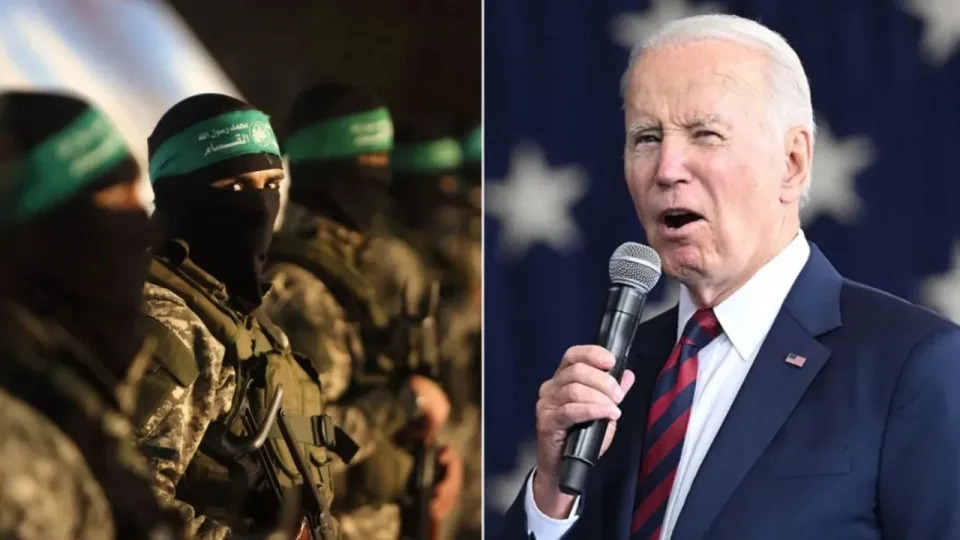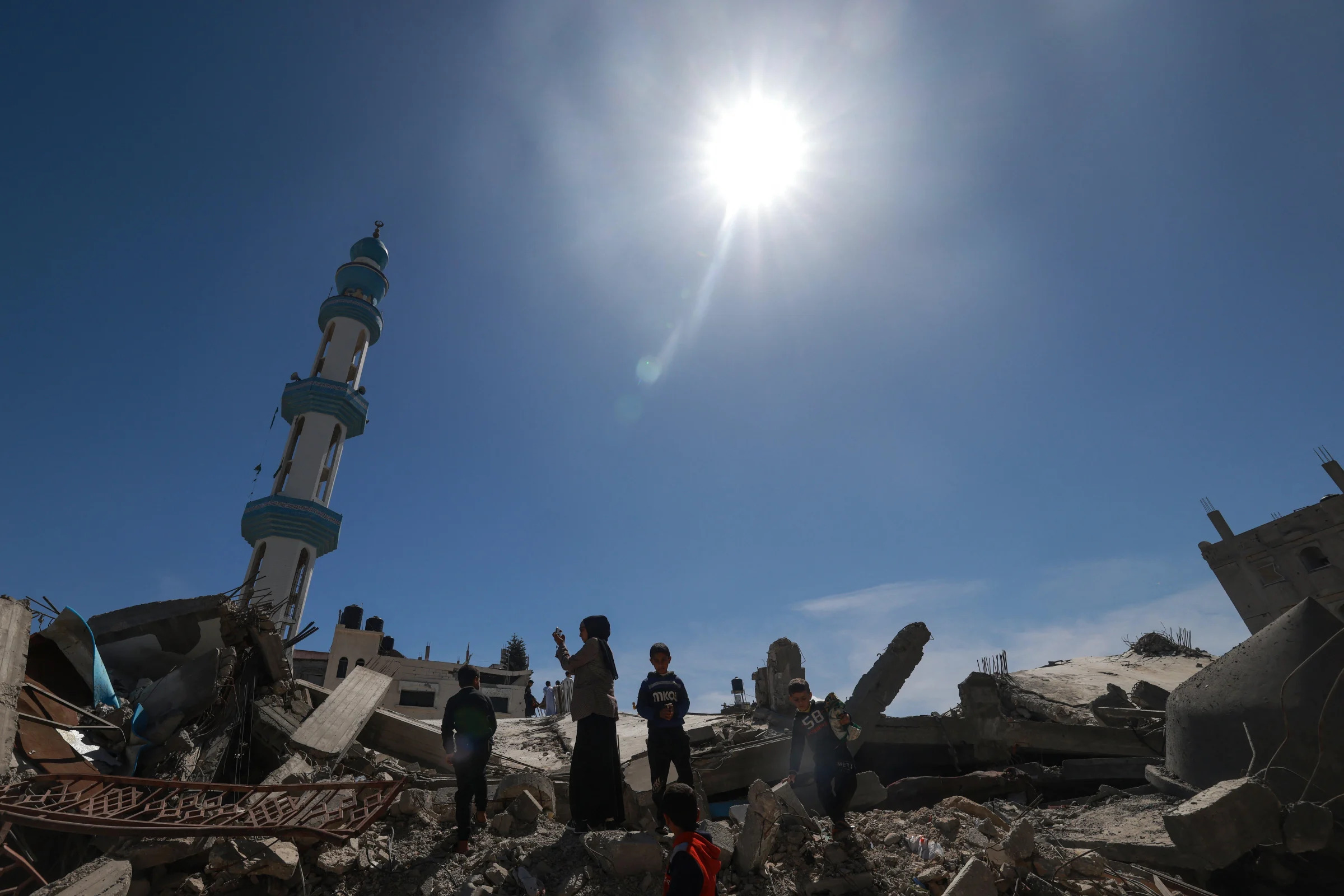Opinion: Cease-fire in Gaza can be attained if people rise up and overthrow Hamas

There is a direct path to getting a cease-fire in Gaza, reopening the borders for food imports, freeing the remaining hostages and recovering the corpses of those Hamas has murdered since abducting them: The people of Gaza rise up and overthrow their Hamas jailers. Doing so would send a direct signal that there are people in the Strip who are opposed to what Hamas has done since it seized control of them 17 years ago.
That there has been no such insurrection means one of two things: 1.) Gazans support what Hamas did on Oct. 7, and thus aren't innocent, or 2.) they are afraid that Hamas will mow them down if they seek to remove its rule. In that case, their hope for liberation lies with the IDF (Israel Defense Forces), and what remains is to identify a way for Gazans to show it, perhaps providing intelligence on where the heroic Yahya Sinwar is hiding among his human shields.
Incidentally, even using the figures Hamas has put out, the total number of Muslim deaths in their war against the Jews is still less than 1% of the 11 million Muslims killed in war since 1948. In that interval, nearly all Jews killed in war have been killed by Muslims.
Hamas proposes cease-fire plan that includes 10-to-1 exchange of hostages, prisoners: report
Hamas has issued a new cease-fire proposal amid its war with Israel that includes an exchange of hostages in Gaza for Palestinian prisoners, according to a report.
The terror group presented the Gaza cease-fire proposal to U.S., Qatar and Egypt mediators on Friday, Reuters reported. It includes the release of Israeli women, children, elderly and sick hostages in exchange for the release of 700 to 1,000 Palestinian prisoners.
Israeli Prime Minister Benjamin Netanyahu’s office appeared to reject the Hamas proposal, saying it was based on "unrealistic demands," per the report.
The new proposal comes a week after negotiations to broker an agreement concluded without a breakthrough.

Hamas has, so far, refused to release all the estimated 100 hostages in its custody, and has kept the remains of around 30 who have died. They are demanding Israel end its ground offensive and withdraw from Gaza.
Hamas also insisted any agreement should end the war.
Mediators with the U.S., Qatar and Egypt have attempted to narrow differences between Israel and Hamas as the humanitarian crisis in Gaza, especially Rafah, continues to worsen.
In February, a draft proposal rejected by Israel included a 40-day pause in all military operations and the exchange of Palestinian prisoners for Israeli hostages. The proposed ratio was 10 to one.

According to the latest proposal, Hamas said it would agree on a date for a permanent cease-fire after the initial exchange of hostages and prisoners.
The Israel-Hamas war was triggered by a Hamas-led attack on southern Israeli towns on Oct. 7. As the war continues past its fifth month, President Biden and other world leaders have repeatedly called for peace in the region and have urged a two-state solution.
A Key Fact That’s Being Overlooked Amid Calls for a Cease-Fire
Amid all the calls for an Israeli cease-fire in the war with Hamas, a few key facts are getting short shrift. Israel has put forth a cease-fire plan. It was negotiated along with U.S., Egyptian, Qatari, and Saudi diplomats. Its terms are quite favorable to Hamas. And Hamas is the party that’s rejecting it.
The plan, which has been on the table for two weeks, calls for a 40-day cease-fire. During this period, all military activity by Israel and Hamas will stop. Israel will suspend aerial surveillance over Gaza for eight hours of each day. Hamas will free 40 hostages—one a day. They will include women, children under 19, people over 50, and ill hostages. In exchange, Israel will free 400 Palestinian prisoners—a 10-to-1 ratio.
Also during this period, Israel will allow much more humanitarian aid to flow into Gaza, including 500 trucks’ worth per day, as well as a commitment to provide 200,000 tents for displaced people and 60,000 caravans. (This part of the deal was outlined before President Biden ordered the U.S. military to build a pier off southern Gaza and to send in still more supplies by ship.) Israel will also allow the entry of heavy machinery and other equipment to remove rubble and rebuild hospitals and bakeries, as well as enough fuel to power the machines—as long as Hamas pledges not to use the machines or the fuel in a way that threatens Israel.
All this is seen as the first phase of an agreement. The second phase hasn’t yet been negotiated, beyond the broad points that it should entail releasing the remaining hostages for an unspecified number of prisoners and gradually letting displaced civilians—except for men of military-service age—return to the northern Gaza Strip, from which they were evacuated in the opening weeks of Israel’s bombing campaign five months ago.
Biden hopes that a six-week cease-fire will be extended and that diplomats use the time, and the pause in fighting, to begin negotiating an enduring political settlement of the broader Israeli-Palestinian conflict—preferably in a solution that divides the narrow piece of land between the Jordan River and the Mediterranean Sea into two states, one Jewish, the other Palestinian, that coexist in peace. Netanyahu has no such hopes or aspirations for this ideal. Nor do the leaders of Hamas, whose reason for existence is to destroy Israel as a Jewish state.
Meanwhile, the six-week cease-fire plan seems as if it has something to offer for all sides. Diplomats from neighboring Arab states have been pushing Hamas to take the deal. The Wall Street Journal recently reported that Qatari officials have threatened to expel Hamas’ political leaders—who have been living in cushy houses and condos in the small, oil-rich nation—if they don’t accept the cease-fire, though no action has yet been taken.
At the same time, a recent story in London’s Financial Times reported that Israel’s military campaign has “shattered” Hamas, which is fighting on simply to survive. One would think the terrorist commanders might be desperate to take the deal. So, why don’t they?
First, they might not agree with the FT’s analysis. As for the civilian casualties in Gaza, they don’t care. A senior Hamas leader openly said, in an interview with Russian TV two weeks into the war, that protecting civilians was the United Nations’ responsibility, not his. They don’t care about the lives or well-being of ordinary Gazans. As long as he and other Hamas leaders survive, down in their tunnels or wherever they happen to be, they’re willing to hang on.
Second, signing a deal with Israel—or adhering to the terms of a deal that an ally has signed with Israel—might dishearten Hamas’ most militant supporters, might suggest that something good could come from addressing Israel with anything but rockets and rifles. (Hamas has warned Gazans not to accept aid from Israel and, according to the Israel Defense Forces, has killed some who have done so.)
Third, regardless of what its leaders really think about the first phase of a cease-fire, Hamas might want to resist any subsequent phases—and the best way to avoid those phases is to reject the first one. When the Hamas terrorists retreated to Gaza after their Oct. 7 killing spree, they grabbed about 250 hostages for two reasons: first, to trade them for prisoners later on; second, in the meantime, to deter Israel from bombing Hamas’ hideouts and tunnels without any restraint whatsoever, for fear that the bombs would kill the hostages too. (Some hostages—it is unknown how many—have died, whether from the bombing or from other causes.) Once the last hostage has been freed, Hamas’ leaders know that their own days are severely numbered.
This explains Hamas’ counteroffer at the peace talks. It demands a permanent cease-fire (later revised to a cease-fire lasting 4½ months), and it demands that all Israeli troops leave Gaza before any hostages are released.
Netanyahu has rejected these conditions as “delusional.” On this point, he is right. A complete withdrawal of troops and a committed end to the war would leave Israel without the means to enforce the release of hostages. It would also allow Hamas to rebuild its military and resume attacking Israel, whether with rocket fire or another attempted incursion.
Hamas issued a new plan on Friday, offering to free hostages who are women, children, elderly, or sick—presumably the same 40 specified in the plan already on the table—in exchange for the release of up to 1,000 Palestinian prisoners, 100 of whom are serving life sentences. Reports on the revised plan also suggest that it requires the withdrawal of Israeli troops to occur after this initial hostage release, in a second phase, along with the release of all remaining hostages and prisoners, as well as a formal, permanent cease-fire. The Israeli government is studying the proposal, though Netanyahu has denounced it as “still absurd.”
At the same time, as if to brush the new proposal aside, Netanyahu announced that he has approved the Israeli military’s plan to push ahead to Rafah, the town on the southern tip of Gaza where Hamas’ leaders are said to be concentrated—though 1.3 million civilians, many of them evacuees from northern Gaza, are also huddled there, many without shelter, food, or medicine.
Still, Israeli diplomats headed back to Qatar for another round of talks on hostages, leaving open—perhaps deliberately—the possibility that the push to Rafah might be delayed or canceled if Hamas is pressured into accepting the 40-day cease-fire deal.
Biden has urged Netanyahu not to move against Rafah without a plan to protect or evacuate the civilian population. The prime minister says there is such a plan, but it’s unclear what it is or how any plan could be effective, given the geography and Egypt’s reluctance to open its own border with Gaza so that civilians can stream into the Sinai.
According to the Gazan Health Ministry, more than 30,000 Palestinians have been killed in the war since it began five months ago. Israel bombed and invaded Gaza after the Hamas terrorist group, which controls the strip, crossed its carelessly guarded northern border and killed 1,163 Israelis—the largest number of Jews killed in one day since the Holocaust.
The next few days could reveal whether the war will come to a halt, at least for a while, or whether the bloody fighting will grind on.
- Questions and Answers
- Opinion
- Story/Motivational/Inspiring
- Technology
- Art
- Causes
- Crafts
- Dance
- Drinks
- Film/Movie
- Fitness
- Food
- Игры
- Gardening
- Health
- Главная
- Literature
- Music
- Networking
- Другое
- Party
- Religion
- Shopping
- Sports
- Theater
- Wellness
- News
- Culture
- War machines and policy


